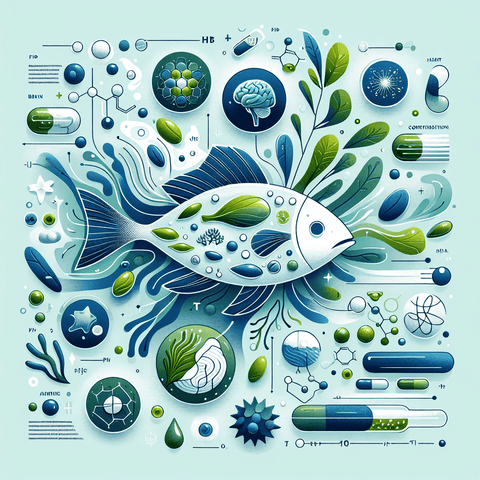Understanding Vitamin D in Nutritional Supplements: What It Is and Why It Matters
Vitamin D is a fat-soluble vitamin that plays a critical role in bodily health, impacting everything from bone structure to immune defense. Found in very few foods naturally, vitamin D stands out due to its unique synthesis route: it can be synthesized by the human body through exposure to ultraviolet B (UVB) rays from sunlight. Structured more like a hormone than a traditional vitamin, vitamin D is involved in over 200 biochemical processes throughout the body. Its popularity as a dietary supplement stems from growing evidence that a significant portion of the global population is deficient in this nutrient — due in large part to lifestyle factors such as limited sun exposure, use of sunblock, indoor living, and variations in skin pigmentation.
There are technically multiple forms of vitamin D — the most common ones being vitamin D2 (ergocalciferol) and vitamin D3 (cholecalciferol). Both forms are lumped under the general term "vitamin D," but they have distinct characteristics, including their sources, bioavailability, and efficiency in raising serum vitamin D levels. Often, when people refer to "vitamin D," they are implicitly discussing both D2 and D3, though vitamin D3 is typically regarded as the more beneficial form due to being more potent and longer-lasting in the bloodstream.
In modern diets, especially in regions where sun exposure is limited or restricted by lifestyle, vitamin D supplementation has become essential. While some foods are fortified with vitamin D (such as dairy products and cereals), getting adequate amounts through diet alone is rarely sufficient. As a result, millions of people turn to vitamin D supplements to maintain appropriate blood levels for optimal health.
The importance of vitamin D in the human diet cannot be understated. It supports calcium and phosphorus absorption — two minerals vital for bone health — and plays roles in muscle function, nerve signaling, and immune regulation. A chronic deficiency in this nutrient can lead to brittle bones, increased susceptibility to infections, and in severe cases, diseases like rickets in children and osteomalacia in adults.
It’s crucial to understand what’s inside your supplement. When choosing between vitamin D2 and D3, or supplements simply labeled as “vitamin D,” knowing the differences can enable you to make an informed choice tailored to your specific health requirements. To explore a curated selection of vitamin D supplements containing both vitamin D2 and D3, including high-potency options, visit the Topvitamine.com Vitamin D collection.
Vitamin D Metabolism: How Your Body Activates and Uses Vitamin D and Vitamin D3
The metabolism of vitamin D is a complex, multi-step process involving several organs and biochemical conversions. Unlike most vitamins, vitamin D is biologically inactive in its initial form. Whether obtained through the skin from sun exposure, ingested in food, or consumed via supplements, both vitamin D2 and D3 require conversion to become physiologically active.
When skin is exposed to UVB radiation, 7-dehydrocholesterol in the skin is converted into vitamin D3. This nutrient then travels to the liver, where it is hydroxylated into 25-hydroxyvitamin D (25(OH)D), also known as calcidiol. This is the main circulating form of vitamin D and is generally what’s measured in blood tests to determine vitamin D status. The next step occurs in the kidneys, where 25(OH)D is converted into 1,25-dihydroxyvitamin D (1,25(OH)₂D), also known as calcitriol — the hormonally active form of vitamin D.
Vitamin D2 and D3 follow similar metabolic pathways, but key differences exist in their affinity for the vitamin D binding protein in the bloodstream, their rate of metabolism, and their final bioactivity. Studies have consistently demonstrated that vitamin D3 has a greater beneficial impact on 25(OH)D levels than vitamin D2. Its superior stability and stronger receptor binding facilitate higher efficacy and extended duration in the bloodstream. In contrast, vitamin D2 is more quickly broken down and has weaker receptor binding affinity.
Another pivotal factor in vitamin D metabolism is the health of the liver and kidneys. Individuals with impaired renal or hepatic function may struggle to metabolize vitamin D effectively, leading to a decreased conversion of the nutrient into its active form. For such individuals, supplementation with already hydroxylated versions of vitamin D, under medical supervision, may be necessary.
Metabolism impacts not just the effectiveness of vitamin D supplements, but also their dosage requirements. For example, someone with compromised liver or kidney function might need a different formulation or dosage than a healthy adult. Additionally, genetics, age, obesity, and concurrent medication use can all influence vitamin D metabolism, thereby affecting the optimal supplement form and quantity. For a closer look at trusted formulations including both vegan and animal-derived options, see Topvitamine’s vitamin D collection.
Vitamin D Sources: Natural, Dietary, and Supplement Forms of the Nutrient
There are three main ways to obtain vitamin D: sunlight exposure, diet, and supplements. Among these, sunlight remains the most effective and natural method. When sunlight hits the skin, it triggers the conversion of cholesterol into vitamin D3. However, factors such as sunscreen use, high latitude, air pollution, clothing, age, and skin pigmentation all significantly affect how much vitamin D the body can produce from sunlight.
Dietary sources of vitamin D are relatively limited. Fatty fish such as salmon, mackerel, and sardines are among the richest natural food sources. Cod liver oil is another potent source. Some foods, like milk, plant milks, orange juice, and breakfast cereals, are fortified with either vitamin D2 or D3. Mushrooms exposed to sunlight or UV light are one of the few plant-based sources of vitamin D2 but are less bioavailable compared to animal-based sources of D3.
Vitamin D2, or ergocalciferol, is derived from plant sources and fungi. It’s primarily found in fortified foods and vegetarian or vegan supplements. Vitamin D3, or cholecalciferol, is usually derived from animal-based sources such as lanolin (from sheep’s wool) or fish oil. Today, plant-based vitamin D3 derived from lichen is also available for those seeking vegan alternatives.
Supplementation is often required for those who struggle to get sufficient amounts through sun or food. Vitamin D supplements are available in multiple forms — including tablets, softgels, liquid drops, sprays, and even chewables. Many multivitamin formulations also include vitamin D, though typically in low doses. For individuals with specific health concerns or increased needs, higher-dose standalone supplements are ideal. Product types vary in convenience and absorption rate; for example, sublingual drops are quickly absorbed through the mucous membranes while tablets take longer via digestive breakdown.
When choosing a supplement product, consider not just the dosage but the source, especially if you comply with specific dietary restrictions such as veganism. To explore plant-based and conventional options, view Topvitamine’s collection of vitamin D supplements, all rigorously sourced and backed by scientific formulation.
Vitamin D Deficiency: Recognizing the Signs, Risks, and Who's Most Vulnerable
Vitamin D deficiency is a global health concern affecting nearly 1 billion people, according to various epidemiological studies. The consequences of too little vitamin D range from subtle to severe, and recognizing the signs can prevent long-term health issues.
Common symptoms of deficiency include fatigue, general weakness, bone or back pain, frequent infections, hair loss, and impaired wound healing. More advanced deficiency can lead to significant bone demineralization, causing conditions such as rickets in children and osteomalacia or osteoporosis in adults. Low vitamin D levels have also been linked to mood disorders such as depression and seasonal affective disorder (SAD), although more studies are needed to confirm direct causality.
Certain groups are more at risk for deficiency. Older adults produce less vitamin D through their skin and often have lower dietary intake. Individuals with darker skin naturally synthesize less vitamin D due to higher melanin content. Those who work indoors, live in northern latitudes, wear concealing clothing for religious or cultural reasons, or use sunscreen regularly are also at heightened risk. Additionally, people with medical conditions affecting fat absorption (like Crohn’s disease or celiac disease) or those who take medications that interfere with vitamin D metabolism require closer monitoring.
Testing serum 25(OH)D levels through a simple blood test is the standard way to assess vitamin D status. Levels below 20 ng/mL (50 nmol/L) typically indicate deficiency, while levels between 20-30 ng/mL are considered insufficient. Optimal ranges are generally between 30 and 50 ng/mL, although exact recommendations may vary by health authority.
Public health organizations are becoming more proactive in addressing the widespread nature of vitamin D deficiency, with many recommending universal supplementation, particularly during the months of limited sunlight. For individuals looking to combine bone-supporting nutrients for maximum effectiveness, the addition of magnesium or vitamin K2 may help. For synergistic products that unify these benefits, view the Magnesium and Vitamin K2 collections on Topvitamine.com.
Vitamin D Supplementation: Choosing the Right Form and Dosage for Optimal Health
When it comes to supplementation, choosing the right form of vitamin D is essential to ensure efficacy, safety, and alignment with your individual health goals. Vitamin D2 and D3 are both approved for human use, but research overwhelmingly indicates that vitamin D3 is the more potent and long-lasting form. D3 leads to a more substantial and more sustained increase in serum 25(OH)D concentrations than D2. Consequently, many health professionals recommend D3 as the preferred supplement option.
Vitamin D3 supplements typically come in doses ranging from 400 IU (10 μg) to 10,000 IU (250 μg), with common daily maintenance dosages ranging between 800 and 2000 IU. Optimal dosage depends on age, sun exposure, diet, body weight, and baseline vitamin D levels. Individuals with known deficiencies may be prescribed higher dosages on a temporary basis under medical supervision. The European Food Safety Authority (EFSA) sets the tolerable upper intake level at 4000 IU per day for adults to prevent toxicity.
While vitamin D toxicity is rare, excessive intake over long periods can lead to hypercalcemia (high calcium levels), which may cause nausea, weakness, and kidney issues. For this reason, regular monitoring through blood tests is advised for high-dose users. Incorporating vitamin D with healthy fats in the diet also enhances absorption, as it is a fat-soluble vitamin. Additionally, co-nutrients such as magnesium and vitamin K2 help regulate calcium transport and utilization — supporting cardiovascular and skeletal health.
Ultimately, the right supplement form should fit into your lifestyle, diet, and ethical considerations. Vegan options, such as lichen-derived vitamin D3, are now widely available and provide effective alternatives to lanolin-based D3. To browse high-quality, lab-tested supplements designed to match your personal needs, check out the Vitamin D supplement collection on Topvitamine.com. A wide selection of dosages and delivery formats ensures you’ll find the right fit.
Vitamin D Benefits: Why Enough of This Nutrient Is Essential for Your Well-being
Vitamin D plays a foundational role in maintaining multiple aspects of health, from bone integrity to immune efficiency. One of its primary functions is regulating calcium and phosphorus absorption in the intestines — minerals critical for building and maintaining strong bones and teeth. Without adequate vitamin D, bones can become thin, brittle, or misshapen. It is a cornerstone nutrient in the prevention and management of osteoporosis, especially in postmenopausal women and older adults.
Aside from skeletal benefits, vitamin D is also indispensable for immune health. Research shows that it enhances the pathogen-fighting effects of monocytes and macrophages, critical white blood cells in the first line of immune defense. It also plays a regulatory role, preventing excessive inflammatory responses. While not a cure or treatment, adequate vitamin D levels are associated with reduced risk of respiratory tract infections and overall immune resilience during viral seasons.
Emerging scientific literature also explores vitamin D’s association with mood regulation, indicating a possible link between low vitamin D and higher incidence of depression. Though not definitively proven as a treatment, supplementation has shown modest support in numerous observational studies, particularly in those with current deficiencies.
Vitamin D’s role goes beyond acute health benefits. When assessed over the long-term, adequate levels have been correlated with reduced risks of certain chronic diseases, including cardiovascular conditions and some forms of cancer. Its role in modulating cell growth, neuro-muscular function, and inflammatory processes is the subject of extensive ongoing research.
Importantly, vitamin D3 — the more potent form — is more effective in achieving these health benefits compared to D2. Ensuring that you’re getting vitamin D3 in your supplement can be a key factor in optimizing your well-being. For more holistic health support, many supplement formulations combine vitamin D3 with omega-3 fatty acids like EPA and DHA for additional cardiovascular and inflammatory benefits.
Conclusion
In summary, while the term “vitamin D” encompasses both D2 and D3, the differences between them are significant. Vitamin D3 (cholecalciferol) is more efficiently synthesized in the body, better maintained in the bloodstream, and overall more effective than vitamin D2 (ergocalciferol) in supporting optimal health metrics. From strengthening bones and immune defenses to reducing potential chronic disease risk, the benefits of sufficient vitamin D levels are wide-ranging and scientifically supported.
Choosing the right form, source, and dosage of vitamin D — especially D3 — is essential in today’s world where lifestyle and environmental factors make deficiency increasingly common. Tailoring your supplementation strategy with high-quality products ensures that you meet your unique health demands. Whether you prefer traditional tablets or plant-based sublingual sprays, Topvitamine.com offers premium vitamin D3 supplements curated for purity, efficacy, and safety.
Q&A Section
Q: What is the primary difference between vitamin D and D3?
A: Vitamin D is a general term that includes both D2 (ergocalciferol) and D3 (cholecalciferol). Vitamin D3 is the more potent and bioavailable form, naturally synthesized in human skin and superior in raising and maintaining vitamin D levels in the blood.
Q: Is vitamin D2 ever a better option?
A: Vitamin D2 may be suitable for those following a strict plant-based diet, although most plant-based vitamin D3 supplements now provide a more effective alternative. D2 also remains an option in some fortified foods and medical prescriptions.
Q: How much vitamin D3 should I take daily?
A: Adults typically require 800–2000 IU daily for maintenance, based on individual factors. Always consult your healthcare provider, especially if considering higher doses.
Q: Can vitamin D3 cause toxicity?
A: While rare, excessive intake — especially above 4000 IU per day over extended periods — can lead to toxicity. Symptoms include nausea, weakness, and high calcium levels. Stay within EFSA-recommended guidelines and monitor blood levels.
Q: Which is better for supplements: oil-based or water-soluble D3?
A: Oil-based D3 is generally better absorbed since vitamin D is fat-soluble. However, water-dispersible forms may be beneficial for those with fat absorption issues.
Important Keywords
- Vitamin D3
- Vitamin D vs D3
- Vitamin D supplements
- Cholecalciferol
- Ergocalciferol
- Difference between vitamin D and D3
- Vitamin D deficiency
- Vitamin D benefits
- Vitamin D dosage
- Vitamin D sources



